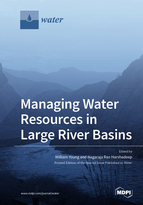Managing Water Resources in Large River Basins
A special issue of Water (ISSN 2073-4441). This special issue belongs to the section "Water Resources Management, Policy and Governance".
Deadline for manuscript submissions: closed (31 July 2020) | Viewed by 52123
Special Issue Editors
Interests: river basin management; water information; integrated water management; water security; water systems modelling
Special Issue Information
Dear Colleagues,
Management of water resources in large rivers basins typically differs in important ways from management in smaller basins. While in smaller basins the focus of water resources management may be on project implementation, irrigation and drainage management, water use effciency and flood operations; in larger basins, because of the greater complexity and competing interests, there is often a greater need for long-term strategic river basin planning across sectors and jurisdictions, and considering social, environmental and economic outcomes. This puts a focus on sustainable development, including consumptive water use and non-consumptive water uses, such as inland navigation and hydropower. It also requires consideration of hard or technical issues—data, modelling, infrastructure—as well as soft issues of goverance, including legal frameworks, policies, institutions and political economy. This Special Issue of Water traverses these hard and soft aspects of managing water resources in large river basins through a series of diverse case studies from across the globe that demonstrate recent advances in both technical and goverance innovations in river basin management.
Dr. William Young
Dr. Nagaraja Rao Harshadeep
Guest Editors
Manuscript Submission Information
Manuscripts should be submitted online at www.mdpi.com by registering and logging in to this website. Once you are registered, click here to go to the submission form. Manuscripts can be submitted until the deadline. All submissions that pass pre-check are peer-reviewed. Accepted papers will be published continuously in the journal (as soon as accepted) and will be listed together on the special issue website. Research articles, review articles as well as short communications are invited. For planned papers, a title and short abstract (about 100 words) can be sent to the Editorial Office for announcement on this website.
Submitted manuscripts should not have been published previously, nor be under consideration for publication elsewhere (except conference proceedings papers). All manuscripts are thoroughly refereed through a single-blind peer-review process. A guide for authors and other relevant information for submission of manuscripts is available on the Instructions for Authors page. Water is an international peer-reviewed open access semimonthly journal published by MDPI.
Please visit the Instructions for Authors page before submitting a manuscript. The Article Processing Charge (APC) for publication in this open access journal is 2600 CHF (Swiss Francs). Submitted papers should be well formatted and use good English. Authors may use MDPI's English editing service prior to publication or during author revisions.
Keywords
- river basin planning
- sustainable development
- water governance
- transboundary cooperation
- flood forecasting
- intersectoral allocation







